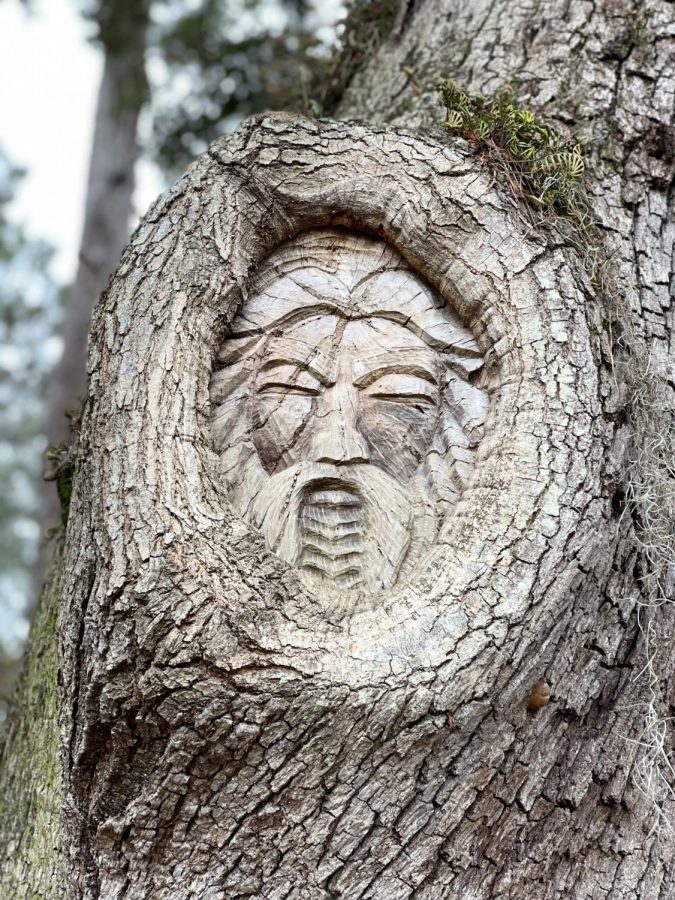The talking trees of St. Simon’s
St. Simons Island is home to over forty tree spirits, twelve of which are located on public property. The faces, carved by Keith and Devon Jennings, reflect a diverse range of cultures.
Nestled along vast wetlands and engulfed by golden trees, St. Simons Island is home to various plants, animals, and tree spirits.
St. Simons Island’s otherworldly beauty is enhanced by a symphony of orange shades and a mosaic of Spanish moss draping the enigmatic oak trees.
If these trees could speak, they would chronicle enchanting tales.
As early as the 1980s, numerous carvings began emerging from various locations around the island and were attributed to a North Carolina craftsman named Keith Jennings. While not a local, Jennings felt drawn to the island because of its magnificent oaks, which beckoned to him.
Through these carvings, Jennings pays tribute and immortalizes sailors who were lost at sea. A closer look, however, reveals that there is more to these depictions than meets the eye.
It all started in Jennings’s backyard, where the artist transformed a damaged tree into a piece of art. Visitors were astounded by the charming tree, and soon, the tree-hugger started taking on projects for individuals and local businesses. As Jennings put it, “I carved an image into a tree in my backyard, and people who came to visit loved it.”
The carvings became so popular that The Golden Isles Convention and Visitors Bureau invited the artist to create carvings for the public. His first public work made its debut in 1982.
Legend has it that Jennings created a wooden priestess in the backyard of a tavern.
Today, 40 years later, the tradition is being kept alive by Devon Jennings, the artist’s son, who is picking up his father’s chisel.
The melancholic depictions exhibit the deep communication between the artists and the loquacious trees. In fact, their work is guided by the tree spirits. As Keith Jennings said, “The trees really do all of the work.”
Jennings believes that anyone can connect with the trees. The artist encourages observers to interpret the spirits independently by creating their own folklore and mythology.
To the Jennings duo, imprinting the trees is more than just putting shapes into wood; for them it is a legacy passed down from father to son. It is their way of leaving a mark on the island.
Jennings has created about 40 carvings, but only 20 have been found. Visitors continue to discover the island’s treasure by unearthing the hidden trees.
Aside from the tree spirits, the mystical island is home to people of different cultures, including African-American descendants of West African slaves, known as the Gullah-Geeche. The unique culture of the Gullah-Geechee is acknowledged in the Historical Harrington School Cultural Center. For decades, this school has functioned as the primary educational center for three African American communities. Today, the institution serves as a valuable venue to learn about the Gullah-Geechee culture and history.
Set your directions to the “Golden Isles Convention and Visitors Bureau”; the drive is 1 hour and 24 minutes from the San Jose campus.
Leaving a mark is like carving a tree: difficult, but everlasting.
The Legend of Cora
Legend has it that a mesmerizing mermaid named Cora has resided in the seas of the Golden Isles for centuries.
Cora is the perpetual protector of the loggerhead turtles that inhabit the island.
Once the hatchlings reach her, Cora guides them out to the Atlantic Ocean to begin their new lives. The mermaid protects them from fishing nets, instructs them on how to be powerful swimmers, and demonstrates how to eat crabs and conches. As a result of Cora’s protection and guidance, the island’s endangered loggerhead hatchlings survive to become adults.



